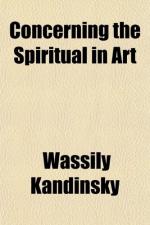The other art, that which is capable of educating further, springs equally from contemporary feeling, but is at the same time not only echo and mirror of it, but also has a deep and powerful prophetic strength.
The spiritual life, to which art belongs and of which she is one of the mightiest elements, is a complicated but definite and easily definable movement forwards and upwards. This movement is the movement of experience. It may take different forms, but it holds at bottom to the same inner thought and purpose.
Veiled in obscurity are the causes of this need to move ever upwards and forwards, by sweat of the brow, through sufferings and fears. When one stage has been accomplished, and many evil stones cleared from the road, some unseen and wicked hand scatters new obstacles in the way, so that the path often seems blocked and totally obliterated. But there never fails to come to the rescue some human being, like ourselves in everything except that he has in him a secret power of vision.
He sees and points the way. The power to do this he would sometimes fain lay aside, for it is a bitter cross to bear. But he cannot do so. Scorned and hated, he drags after him over the stones the heavy chariot of a divided humanity, ever forwards and upwards.
Often, many years after his body has vanished from the earth, men try by every means to recreate this body in marble, iron, bronze, or stone, on an enormous scale. As if there were any intrinsic value in the bodily existence of such divine martyrs and servants of humanity, who despised the flesh and lived only for the spirit! But at least such setting up of marble is a proof that a great number of men have reached the point where once the being they would now honour, stood alone.
II. THE MOVEMENT OF THE TRIANGLE
The life of the spirit may be fairly represented in diagram as a large acute-angled triangle divided horizontally into unequal parts with the narrowest segment uppermost. The lower the segment the greater it is in breadth, depth, and area.
The whole triangle is moving slowly, almost invisibly forwards and upwards. Where the apex was today the second segment is tomorrow; what today can be understood only by the apex and to the rest of the triangle is an incomprehensible gibberish, forms tomorrow the true thought and feeling of the second segment.
At the apex of the top segment stands often one man, and only one. His joyful vision cloaks a vast sorrow. Even those who are nearest to him in sympathy do not understand him. Angrily they abuse him as charlatan or madman. So in his lifetime stood Beethoven, solitary and insulted.
[Footnote: Weber, composer of Der Freischutz, said of Beethoven’s Seventh Symphony: “The extravagances of genius have reached the limit; Beethoven is now ripe for an asylum.” Of the opening phrase, on a reiterated “e,” the Abbe Stadler said to his neighbour, when first he heard it: “Always that miserable ‘e’; he seems to be deaf to it himself, the idiot!”]




